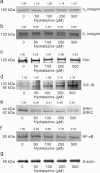The mechanism of hydralazine-induced collagen biosynthesis in cultured fibroblasts
- PMID: 23344524
- PMCID: PMC3597333
- DOI: 10.1007/s00210-013-0836-5
The mechanism of hydralazine-induced collagen biosynthesis in cultured fibroblasts
Abstract
The finding that hydralazine (HYD) affects collagen metabolism led us to investigate the mechanism of its action on collagen biosynthesis, prolidase expression and activity, expression of α2β1 integrin, insulin-like growth factor-I receptor (IGF-IR), focal adhesion kinase (FAK), mitogen-activated protein (MAP) kinases (ERK1, ERK2), and transcription factors hypoxia-inducible factor-1α (HIF-1α) and nuclear factor-κB p65 (NF-κB p65) in human dermal fibroblasts. Confluent fibroblasts were treated with micromolar concentrations (50-500 μM) of HYD for 24 h. HYD had no influence on cell viability. It was found that HYD-dependent increase in collagen biosynthesis was accompanied by a parallel increase in prolidase activity and expression, HIF-1α expression, and decrease in DNA biosynthesis, compared to untreated cells. Since collagen biosynthesis and prolidase activity are regulated by a signal induced by activated α2β1 integrin receptor as well as IGF-IR, the expression of these receptors was measured by Western immunoblot analysis. The exposure of the cells to HYD contributed to the increase in IGF-IR expression without any effect on α2β1 integrin receptor and FAK expressions. It was accompanied by a decrease in expression of MAP kinases and NF-κB p65, the known inhibitor of collagen gene expression. The data suggest that the HYD-dependent increase of collagen biosynthesis in cultured human skin fibroblasts results from activation of IGF-IR expression and prolidase activity and downregulation of NF-κB p65.
Figures



References
-
- Carmichael J, Degraff W, Gazdar A, Minna J, Mitchell J. Evaluation of a tetrazolinum-based semiautomated colorimetric assay: assessment of chemosensitivity testing. Cancer Res. 1987;47:936–942. - PubMed
-
- Chinard FP. Photometric estimation of proline and ornithine. J Biol Chem. 1952;199:91–95. - PubMed
-
- De la Cruz-Hernández E, Perez-Plasencia C, Pérez-Cardenas E, Gonzalez-Fierro A, Trejo-Becerril C, Chávez-Blanco A, Taja-Chayeb L, Vidal S, Gutiérrez O, Dominguez GI, Trujillo JE, Duenas-González A. Transcriptional changes induced by epigenetic therapy with hydralazine and magnesium valproate in cervical carcinoma. Oncol Rep. 2011;25:399–407. - PubMed
Publication types
MeSH terms
Substances
LinkOut - more resources
Full Text Sources
Other Literature Sources
Medical
Miscellaneous

